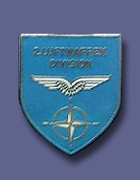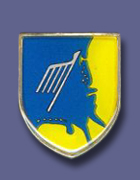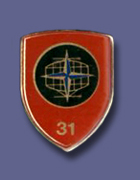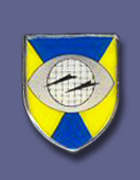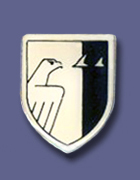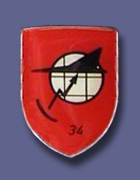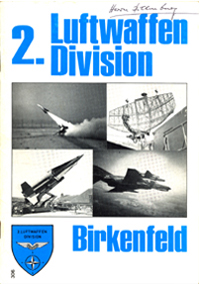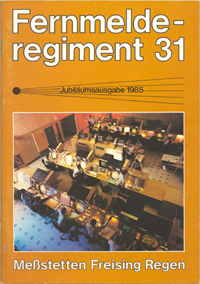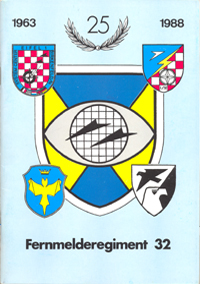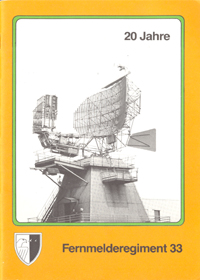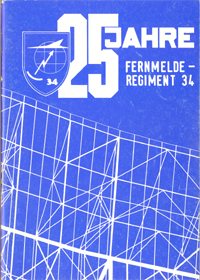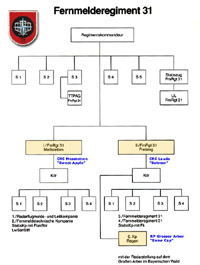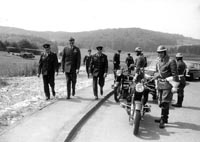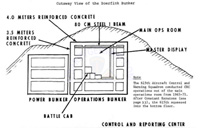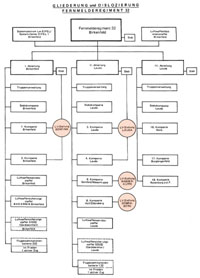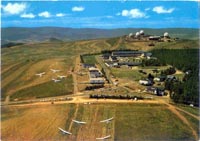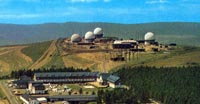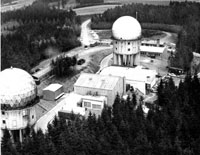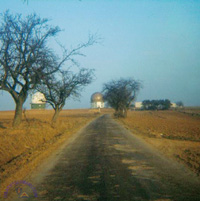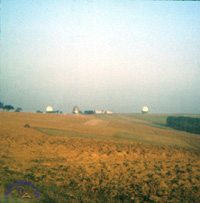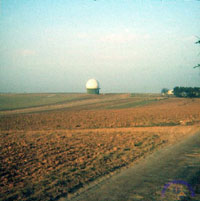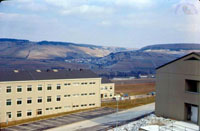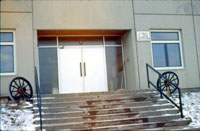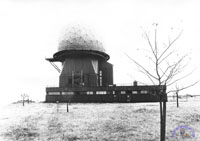Tactical Air Control System |
|||||||||||||||||||||||||||||||||||||||||||||||||||||||||||||||||||||||||||||||||||
|
|||||||||||||||||||||||||||||||||||||||||||||||||||||||||||||||||||||||||||||||||||
| NATO Air Defense Ground Environment - Units, 1970s and 80s | |||||||||||||||||||||||||||||||||||||||||||||||||||||||||||||||||||||||||||||||||||
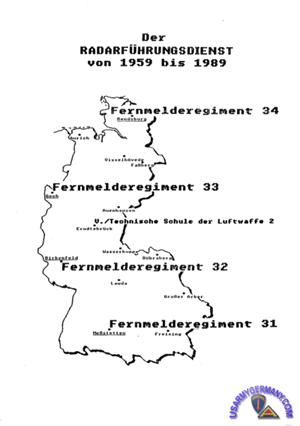 A German Air Force historical manuscript (very detailed) on the Aircraft Control and Warning mission in GAF and AFCENT from 1959 to the end of the Cold War |
|||||||||||||||||||||||||||||||||||||||||||||||||||||||||||||||||||||||||||||||||||
| Webmaster note: I recently found a copy of a very detailed and interesting German historical manual that covers the integration of the German Air Force into the AIRCENT air defense ground environment in Germany in the 1950s and the role GAF signal units played in operating the various air defense radar sites in 2nd and 4th ATAF. Will post excerpts (translated into English) in the coming weeks (starting in mid-March 2011). |
|||||||||||||||||||||||||||||||||||||||||||||||||||||||||||||||||||||||||||||||||||
|
|||||||||||||||||||||||||||||||||||||||||||||||||||||||||||||||||||||||||||||||||||
|
|||||||||||||||||||||||||||||||||||||||||||||||||||||||||||||||||||||||||||||||||||
|
|||||||||||||||||||||||||||||||||||||||||||||||||||||||||||||||||||||||||||||||||||
|
|||||||||||||||||||||||||||||||||||||||||||||||||||||||||||||||||||||||||||||||||||
|
|||||||||||||||||||||||||||||||||||||||||||||||||||||||||||||||||||||||||||||||||||
|
|||||||||||||||||||||||||||||||||||||||||||||||||||||||||||||||||||||||||||||||||||
|
|||||||||||||||||||||||||||||||||||||||||||||||||||||||||||||||||||||||||||||||||||
|
|||||||||||||||||||||||||||||||||||||||||||||||||||||||||||||||||||||||||||||||||||
|
|||||||||||||||||||||||||||||||||||||||||||||||||||||||||||||||||||||||||||||||||||
|
|||||||||||||||||||||||||||||||||||||||||||||||||||||||||||||||||||||||||||||||||||
| NATO RADAR UNITS | |||||||||||||||||||||||||||||||||||||||||||||||||||||||||||||||||||||||||||||||||||
|
|||||||||||||||||||||||||||||||||||||||||||||||||||||||||||||||||||||||||||||||||||
|
|||||||||||||||||||||||||||||||||||||||||||||||||||||||||||||||||||||||||||||||||||
| Does anybody have a copy of a 4. LwDiv Unit History that they could scan and send to me? | |||||||||||||||||||||||||||||||||||||||||||||||||||||||||||||||||||||||||||||||||||
| Fernmelderegiment 31 | |||||||||||||||||||||||||||||||||||||||||||||||||||||||||||||||||||||||||||||||||||
|
|||||||||||||||||||||||||||||||||||||||||||||||||||||||||||||||||||||||||||||||||||
| (Source: Email from Werner Menzel, FmRgt 31) | |||||||||||||||||||||||||||||||||||||||||||||||||||||||||||||||||||||||||||||||||||
| By chance I happened to find your site on the Internet. I might have some answers for your questions, respectively even new information. - The predecessor of BURGLENGENFELD (initial callsign TRUMPET, operating unit 12./FmRgt 31) was located at REGENSBURG (last callsign MERCURY, USAF operating unit, shared with 13./FmRgt 31). Both sites were purely manual RPs. BURGLENGENFELD was later on equipped with some simple interface equipment to automatically report a very limited number of manually selected tracks to 412L, however, it never was a 412L site. As GAF officer, I spent some time in Freising, Regensburg, Burglengenfeld, Giebelstadt and Birkenfeld: From 1963 to 1966 in operations and then as member of SPATS and PCB until 1975 in programming. But I did not see the end of 412L, because I wound up in the NATO Programming Centre, first as military and later as civilian. |
|||||||||||||||||||||||||||||||||||||||||||||||||||||||||||||||||||||||||||||||||||
| ADDITIONAL INFORMATION CRC's and Bunkers |
|||||||||||||||||||||||||||||||||||||||||||||||||||||||||||||||||||||||||||||||||||
|
|||||||||||||||||||||||||||||||||||||||||||||||||||||||||||||||||||||||||||||||||||
| Typically, each CRC site was run by a battalion size organization (Abteilung, named with roman numbers) with: Some of these "battalions" had extra companies assigned that operated small remote sites: All 412L sites had multiple duplex interfaces and reported not only to their parent site (only SOC-3 Kindsbach was in receive-only mode). In the last years of the system basically everyone in the system saw everything, the airpicture was almost common in the system. Crosstelling was performed in different ways: The purpose of Crosstell was to I remember only few x-tell operators (one or two) at work (in Freising) and their importance diminished as the system developed. Towards the end of 412L there was one huge area only and every 412L site essentially reported everything they could track. Some kind of filtering was conducted only in the data exchange with the "outside world". SOC operations: Even when colocated with a CRC, operations were physically separated in different rooms, however, the SOC (or alternate SOC) staff could see the large light wave produced general situation display through the windows in the back of the CRC ops room. SOC-4 (Drachenbronn, France) SOC-4 (Rampart) was in control of the southern sector (of FOURATAF) until the French quit the military integration (1966/67). However, they never interrupted air defense integration or crosstell and with 412L (Tactical Air Control System) and Strida (French equivalent of the 412L) being operational, even automated data exchange started (Link 1 running at 600 bits/sec, to my knowledge via DBP landlines and/or microwave connections). As far as crosstell was concerned, one could consider their colocated CRC as an extension of 412L. From the 412L side, track production in France as not transparent, initially all other French AD sites ran still manual. In conjunction with radar alignment problems I managed to visit D/B once in the early '70s, but operational aspects were of lesser importance then to me. As far as maybe a French detachment being assigned/attached to the CRC atFreising, I am not aware of any French at Freising. I do think there were French liaison officers at the larger bunkers (alternate SOC role). CRC Freising My assignments at Freising, Regensburg and even partially at Burglengenfeld fell into the pre-412L time with strictly manual operations. During that time there were 412L system acceptance tests and demos going in the new bunker, but I was never involved in those events. Actually, I saw the new site only about 10 years later. If I remember right, the manual operations site and the radars were colocated. Also, I believe that the 604th ACWS (at Freising) was in the process of pulling out or had pulled out already. The new bunker (FRIDOLIN) was built at a location different from the manual site. I am not sure whether the location of the manual site was reused as new radar location. Radar coverage was oriented mainly east and north towards the Warsaw Pact area and not so much to neutral Austria. The responsibility of each CRC/RP site varied with the operational status of the neighbours. At some time in the 1970s, there was a master site concept introduced, which allowed one site to run essential functions like ID in a centralised mode. Thus, one site could take over most of the functions while the others only acted as RPs. RP Mercury at Regensburg was like the old manual CRP Freising non-hardened and operated in a better type of tent colocated with the search and heightfinder radars. RP Trumpet at Burglengenfeld was hardened and operated in a small bunker separated from search and height finders. Trumpet was part of the early warning radar concept. Both RPs were in principle organised like all sites, indians up front and chiefs in the back row(s). Initially both RPs reported to Freising (Racecard) manually through voicetell, later on Trumpet used some special equipment where the operator could manually trigger transmission of a limited number of tracks to the parent site where the data were automatically merged into the air picture. I suppose that both sites had to cover the ADIZ and certainly the CSSR. Trumpet as EW site should have reported especially east block activities higher up, directly to the EW Cell at ADOC (?) level, but to my knowledge, this connection was never established. When I arrived (at Regensburg - JAN 1964), the USAF personnel had already left. Regensburg was a very small manual RP which stopped operations shortly after I arrived. Mmost of the GAF personnel were transferred to Freising. The equipment at Regensburg was outdated and probably was scrapped. I believe that at Freising newer equipment was installed along with the introduction of 412L. CRC Giebelstadt CRC Giebelstadt (Wheaties) ran 412L in a non-hardened tent-type site situated right next to the runway. They shut down operations in the third quarter of 1968. The equipment received new cabling and was moved to CRC Lauda (Batman) and installed there. A condemned WW II aircraft hangar on the airbase housed another 412L system which was used by SPATS for software testing and analysis. It was mounted on a handful of truck trailers sitting in the middle of this huge building. Due to the very bad state of the roof, entry was really forbidden by the German base administration authorities. Therefore everyone that had business there was obliged to wear the hard hat (which conflicted also with other regulations about work on electric equipment). By the way, some interesting details: - This SPATS equipment had spent some time in West-Berlin on Tempelhof airbase before and was moved to Börfink (Hardtire) afterwards. - Giebelstadt was one of the locations Gary Powers ad friends used as one of their operating bases for their U-2 missions. - During WW II Giebelstadt was also one of (two?) German jet fighter bases (protection of the ball-bearing factories at Schweinfurt). Giebelstadt's callsign was Wheaties (Dora probably was the pre-412L callsign). Wasserkuppe and Döbraberg sound correct. The problem with callsigns is that you have to differentiate between manual pre-412L and automated 412L times. CRC Meßstetten I think this is correct. Manual CP (?) Türkheim (Joplin) shut down approximately when CRC Messstetten (Strawbasket) opened. ADDITIONAL INFORMATION System Programming, Analysis and Testing Site (SPATS), mission maintenance and support of 412L software under USAF commander 1965 General Electrics as contractor with USAF military support 1966 WESTREX as contractor with USAF military support 1967 arrival of GAF military liaison officer and 1968 purely military unit Locatation: 1965 to Sep 1968 in Giebelstadt and Oct 1968 to Oct 1973 in Börfink with increasing GAF and decreasing USAF staffing (RIF programme) as majority of 412L sites becomes German change in name/command; to Programming Center Birkenfeld (PCB) mission still maintenance and support of 412L software, GAF commander, USAF deputy located: Nov 1973 to ... in Börfink, ... to 412L phase-out in Birkenfeld From 412L to GEADGE to NADGE Some history: For deployment in 4ATAF area 412L (GE) and STRIDA (FR) were developed more or less in parallel and became operational at a time where 2ATAF (BE, northern GE, NL), 5ATAF (IT) and 6ATAF (GR, TU) conducted operations still manually. NADGE was in a planning stage with implementation scheduled for 1972. Three nations (BE, GE and NL) did not want to wait that long and decided to go for GFN as NADGE forerunner. I believe GFN was chosen, because 412L had too many unresolved problems. GFN became operational in 1968 and its software was maintained by the newly established tri-national Programming and Training Centre (PTC) in Glons/BE. When NADGE implementation started in 1972, the NATO Programming Centre (NPC) took over the PTC facility and started maintenance of GFN and NADGE. The PTC training component moved to Erndtebrück/GE as tri-national International Training Centre (ITC). Around 1977 the GFN software was replaced with an especially to GFN hardware adapted version of NADGE software. In the early 1980s hardware maintainance costs for a 412L site reached more than 2000 % of those of a typical NADGE site. So the GEADGE development was decided. In parallel the Airborne Early Warning Ground Environment Integration Segment (AEGIS) was developed and implemented, while GEADGE - due to contractor errors - had to restart from scratch. Many NADGE sites were upgraded to NAEGIS sites and even GEADGE was finally introduced as GEAEGIS. While SPATS, PTC, PCB etc have disappeared, NPC is still alive and busy with maintenance of the successors of above systems (http://www.npc.nato.int) and involved in design, development, testing, and implementation of a future system (http://www.x-software.com/de/References/acsiAccsLoc1.html) |
|||||||||||||||||||||||||||||||||||||||||||||||||||||||||||||||||||||||||||||||||||
| Fernmelderegiment 32 | |||||||||||||||||||||||||||||||||||||||||||||||||||||||||||||||||||||||||||||||||||
| (Source: 25 Jahre Fernmelderegiment 32, Informationsschrift für Gäste und Soldaten, Verlag D. Fölbach, Oct 1988) | |||||||||||||||||||||||||||||||||||||||||||||||||||||||||||||||||||||||||||||||||||
|
|||||||||||||||||||||||||||||||||||||||||||||||||||||||||||||||||||||||||||||||||||
| (Source: Email from Rodrigo Gebhard, Germany) | |||||||||||||||||||||||||||||||||||||||||||||||||||||||||||||||||||||||||||||||||||
| I am submitting some images (Images #4-6, above) I took while visiting the "Batman" radar site at Lauda. The site is located near the village of Löffelstelzen, north of Bad Mergentheim and about 6 km southeast of Lauda. At that time, the radar site was equipped with the AN/FPS-3 (?) search radar, one AN/FPS-6 heigtht finder and an AN/FPS-6C height finder radar. These had been relocated from the inactivated Giebelstadt radar site (callsign: "Weaties"). I am also including two photos of the German kaserne at Lauda, also taken in 1969. 3rd Co, (2nd Bn,) FmRgt 32 was the operations unit. I also served with that unit at one time. |
|||||||||||||||||||||||||||||||||||||||||||||||||||||||||||||||||||||||||||||||||||
| (Source: Email from Chris Neckermann, CRC Lauda and CRC Meßstetten) | |||||||||||||||||||||||||||||||||||||||||||||||||||||||||||||||||||||||||||||||||||
I am with the German Air Force and was previously based at CRC Lauda from 1997 till the location was closed as full ops CRC in 2002 - the Fighter section was closed on 01. April 2002. It was finally closed (Surveillance) in October 2004.
Some information, missing at Page 2 4ATAF ADOC-- The callsign of CRC Lauda was BATMAN. The CRC got the callsign STRAWBASKET in 1973 and was finally renamed BATMAN in 1977. The bunker was conducted by GAF / US in 1967 / 1968 and operational in 1968. Before we left our CRC a unit history (Chronik) was created by a Senior Master Seag., member of our Weapons Section and one of our finest and most experienced fighter controllers. If you are interessted in detailled facts and figures concerning CRC Lauda "BATMAN", I can mail these to you. I will put online the "reunion HP" of the GCI - Tigers BATMAN in the near future on the internet and will mail the link to you ASAP, if you are interessted. |
|||||||||||||||||||||||||||||||||||||||||||||||||||||||||||||||||||||||||||||||||||
| Fernmelderegiment 33 | |||||||||||||||||||||||||||||||||||||||||||||||||||||||||||||||||||||||||||||||||||
| Fernmelderegiment 34 | |||||||||||||||||||||||||||||||||||||||||||||||||||||||||||||||||||||||||||||||||||



